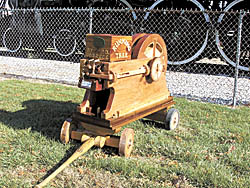
You've never seen anything like this all-wood 1-cyl. gas engine built by Paul Gorrell, Burlington, Iowa.
There's no metal at all in it -- no screws, nuts, nails, or anything else. It's held together with wood pegs and even has a wood gas tank, fuel line and mixer, all of which are coated with gas tank sealer. All the moving parts were penetrated with Minwax wood hardener and sprayed with coats of Teflon Dry Lube high performance formula. They're also lubricated with extra virgin olive oil. The engine even has a striking flint stone ignition.
Eight different kinds of wood were used to build it. The oak pins that hold the engine together can be driven out to take the engine apart for repairs.
"I've been showing equipment at engine shows for 40 years, and this is the best 'draw' I've ever had. People are fascinated by it," says Gorrell.
The engine measures 4 ft. long, 3ft. high and 2 ft. wide and rides on a 4-wheeled cart equipped with a tongue made from a Louisville Slugger bat. Pecan was used for the flywheels, gears, push rod and rocker arms; oak for the frame, wheels, axles, and bolsters; hickory for the inner frames, cylinder, rod and tongue; honey locust for rails; walnut for the platform, nuts, and other miscellaneous parts; cedar for the hopper; mahogany for the pulley; and ebony for the piston and cylinder.
Wood doesn't transfer heat, so Gorrell designed the engine to cool internally. The 3 3/4-in. bore piston has a 7-in. stroke. The engine cools itself by drawing air in and out of the exhaust port three times between firings. "There are three in-and-out strokes between firings, which is what cools the cylinder walls," says Gorrell. "Halfway down, the intake stroke becomes a power stroke so I'm getting two cycles out of one stroke, which accounts for the odd one. I eliminated the compression stroke to get rid of heat.
"When I fired my all-wood engine up the first time I wondered if it would just burn up, but it really sounds like other old antique gas engines. It usually starts easy with a slow quarter turn pull on the flywheel. I enjoy seeing peoples' faces when they hear the engine come to life. The only problem I had was with two burned valves. I knocked the pins out that hold the engine together, fixed the valves, and put everything back in place."
To make the cart's tongue, he drilled a hole through the end of the bat and put a wood pin through it that extends into the front axle so that he can use a Louisville Slugger baseball bat to pull and steer the cart.
Before building the engine, Gorrell even ran each board through a metal detector to make sure there weren't any screws in it. "I found three pieces that I couldn't see on the outside," he notes.
